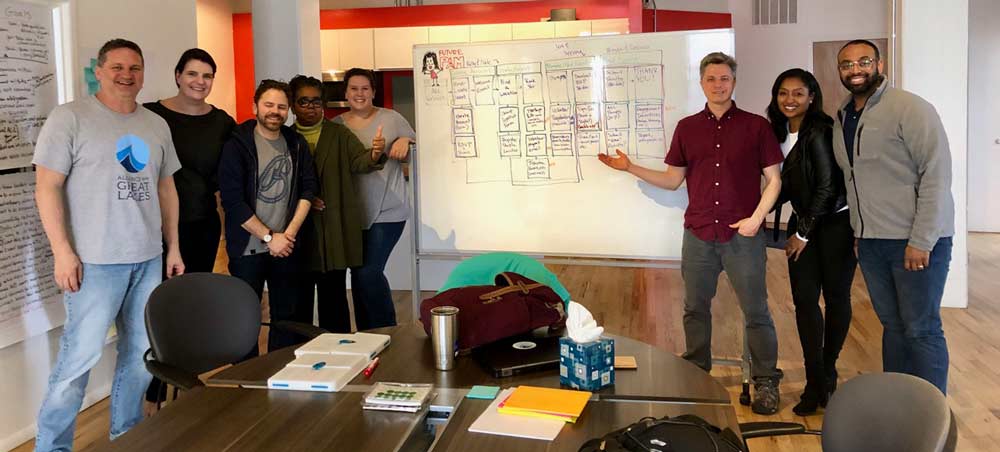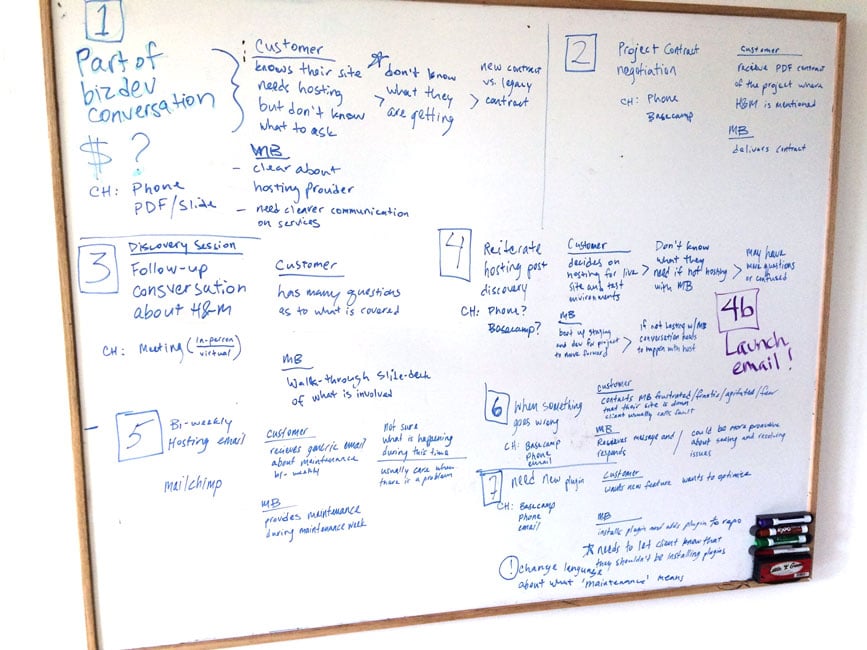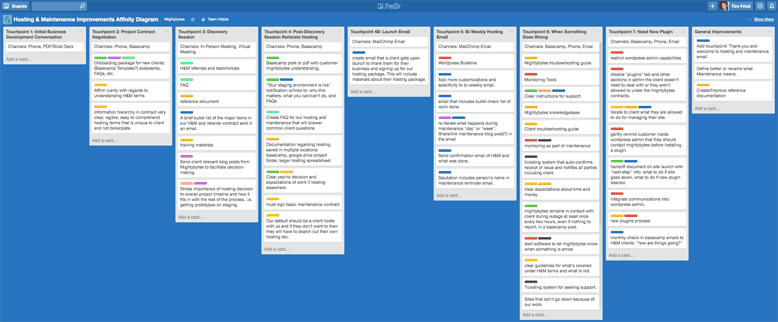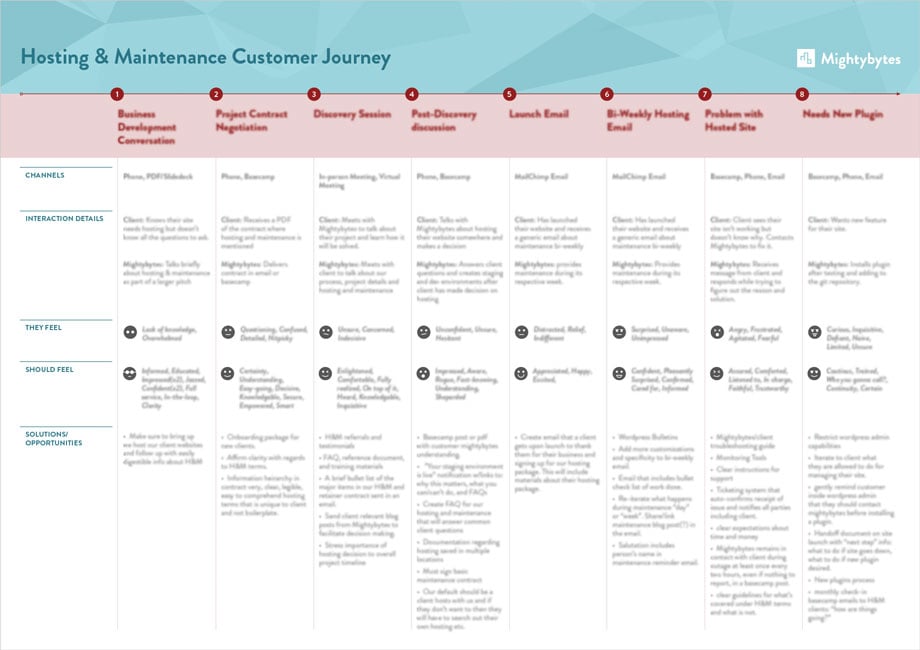Understanding Customer Journey Maps

Creating a customer journey map can help you design better products and services, build trust, and improve your relationships with customers or other stakeholders. Read on to find out how and download a free customer journey map template.
Customer journey mapping is an important research method that can be useful for any organization, regardless of size, type, or industry. Journey maps help teams build educational narratives for customer interactions with your organization.
Often used in marketing and service design, these maps help teams empathize with how customers feel when they interact with your products, services, and organization overall. Going through experience or journey mapping processes helps you better understand stakeholder needs. You’ll learn when people are frustrated, excited, confused, or ambivalent as they interact with your organization and its products, services, or programs.
What’s more, journey maps also provide useful visual representations of elements that influence a customer’s experience. They help people quickly understand and communicate where improvements are needed.

How Customer Journey Maps Improve Relationships
You can apply customer journey maps with varying levels of complexity to various components of your organization. For example:
- Understand a customer’s emotional state as they learn about and interact with your organization overall, or
- Focus on their experience with a single product or service, or
- Hone in on a specific touchpoint, like a website task or customer service feature.
Identifying potential weaknesses in these interactions will help you chart a clearer path toward improvement over time. In turn, this should lead to happier customers.
More importantly, directly involving customers in this process gives you meaningful qualitative feedback as well as a channel to improve stakeholder relationships.
Crafting Circular Customer Journeys
By default, customer journey maps tend to be linear. However, customer experiences can be ongoing, especially if a company is customer-focused, offers subscription-based services to support their products, or has a dedicated customer service team. The customer journey mapping process will help you identify opportunities to re-engage and delight customers by improving services and experiences throughout their life cycle.
In other words, prioritize relationships and think about your sales and marketing efforts as a flywheel instead of a funnel. You’ll find more opportunities for mutual success and shared trust this way.
Adding Impact to the Customer Journey Mix
Additionally, journey maps offer great opportunities to help customers make more responsible or sustainable choices during their interactions with your organization. This can be done in many ways. Here are a few:
- Choice architecture that helps them identify more sustainable options, such as lower emissions shipping or more sustainable packaging, for instance.
- Showcasing local or more ethically sourced products.
- Allowing customers to filter based on different sustainability criteria.
When identifying customer touch points and emotional states in the journey mapping process outlined below, ask yourself whether there are opportunities to improve social or environmental impact while also prioritizing a top-notch experience.
Customer Journey Maps Step-by-Step
Customer journey maps are best created in a collaborative workshop setting. For this workshop, we incorporate a combination of brainstorming and whiteboard exercises to give more depth to the map. Use the five steps below to create your own customer journey map.
First, Who to Invite?
If possible, facilitate customer journey mapping workshops with a group of about five to eight people. Include too many people and the workshop becomes unwieldy or hard to manage. Invite too few people and you might not have diverse enough perspectives.
Ideally, alongside a seasoned facilitator, you want a blend of organizational decision makers, sales and marketing leads, customer service representatives, and yes, actual customers. If customers are unavailable, be sure your team understands assumptions made during the exercises. More importantly, follow up with qualitative interviews to ensure customer perspectives are respresented in the research.
Step 1: Gather Research
To kick off the journey mapping process, collect specific feedback from customers. You might have this already. You might also need to collect it via stakeholder interviews or other research methods. Also, competitive intelligence will help you get a sense of what others in your industry are already doing.
Customer personas can sometimes plays a helpful role in defining customer wants or needs. However, these are usually based on assumptions or broad characteristics.
Choose a research method and amount of work that you feel will produce the best results without wasting time or producing unnecessary data. This will provide a solid foundation to better understand your customers’ specific wants, needs, or problems.
Step 2: Touchpoints and Channels
To produce useful insights that will help you better understand why customers might be dissatisfied or frustrated, first define two things:
- Touchpoints: the specific interactions customers have with your brand (contacting customer service, listening to a sales presentation, and so on).
- Channels: the methods by which communication happens (emails, phone conversations, social media, in-person meetings, etc.).
Create a list of touchpoints that start with the time a customer first interacts with your organization through to scenarios where they might close out the service or stop using a product. For each touchpoint, define the most commonly used communications channels. Use a whiteboard to sketch out the timeline for these touchpoints and included channels through which that contact occurred.

Step 3: Empathy Mapping
Using the touchpoint timeline, conduct empathy mapping exercises. These can help you better understand a customer’s mindset during the interactions defined above. The goal of these exercises is to get a well-rounded understanding of how customers actually feel during specific interactions and cross-reference those with how we hope they will feel.
During this discussion we asked common yet specific questions, like:
- What is the client’s tone of voice when they call about our product or service?
- Are they calling because our recommendations fell short for some reason?
- Are they confused about something in particular?
- What kinds of customer support questions do they ask?
- Are their questions technical in nature or do they relate to how you communicate a specific feature or benefit?
After answering these questions as a group, write down single words or short phrases on sticky notes for each touchpoint to describe how a customer felt during the interaction. Next, follow these up with aspirational words to describe what you hope customers will feel at each touchpoint. Place the sticky notes in columns under each touchpoint.
This encourages conversations about how to improve interactions during each touchpoint. If the discrepancies between actual and aspirational emotions are significant, mark them as priority items for an affinity diagram.
Step 4: Solutions, Opportunities, and the Affinity Diagram
The above steps serve as a foundation for creating an affinity diagram, which is a brainstorming exercise meant to:
- Define potential solutions to a problem.
- Uncover opportunities for improvement.
- Group ideas together based on commonalities.

Reviewing channels, touchpoints, and feelings should uncover ample opportunities to improve your product or service. To create an affinity diagram relevant to your customer journey map:
- Discrepancies: Note discrepancies between actual and aspirational feelings for each touchpoint. Discuss each in detail with your team.
- Opportunities: Define potential opportunities for fast improvement by identifying those discrepancies which can be easily or quickly fixed.
- Possible solutions: Devise several solutions for each touchpoint to help transition negative opinions into positive experiences. If possible, estimate how long each might take.
- Grouping: If applicable, group similar solutions together to identify efficiencies or places where you might get the most traction with one solution across multiple touchpoints.
- Prioritize: Make the most egregious discrepancies, where customers are potentially most frustrated, your biggest priorities.
Identifying the low-hanging fruit will help you make quick fixes, which will no doubt be appreciated. However, understanding where the largest gaps between customer frustration and customer satisfaction exist will likely have the biggest impact. Ultimately, this will create more happy, long-term customers.
Step 5: Creating the Final Customer Journey Map
Finally, create a visual representation of the entire customer journey which represents all of the above steps:
- Insights from your research
- Touchpoints
- Channels
- Feelings
- Potential solutions
How you visualize a customer journey map will depend on the product or service you hope to improve. Some customer journey maps rely heavily on statistics, infographics, and data visualization. The map below focuses on solutions and opportunities over time with brief descriptions of each. You can download a blank version of this template at the end of this article.

Journey Mapping Digital Products and Services
Customer journey maps can be used to improve all existing products or services. Because Mightybytes is a digital agency, we also include discussions about whether (or how) a digital product or service might improve customer satisfaction in the defined touchpoints.
For instance, if one of your organizational goals is to increase donations, mapping out the entire journey a customer follows as they go from first learning about your organization to becoming a regular donor should reveal numerous useful insights.
By isolating each touchpoint along the journey, and the channels in which they take place, you can
- Review your customer’s journey in great detail,
- Better understand their motivations, and
- More accurately determine how an experience might be improved by a digital solution.
For instance, the journey above might be improved by a more streamlined donation form, clearer calls-to-action, easier access to customer or donor support, how-to emails or landing pages, or links to specific items in a knowledge base.
Final Thoughts on Customer Journey Maps
These maps are most useful if you maintain or revisit them over time. For our customer journey map, we defined as many as fifty potential improvements to our hosting and basic maintenance service. While we won’t execute all of these ideas, the list was long enough and the ideas in it strong enough that we’ll revisit the map on a regular basis to ensure progress.
More importantly, incorporating real customer feedback into the process and repeating that process over time helps to guarantee we stay on track with continuous improvement.
While the low-hanging fruit mentioned above may provide quick fixes to simple problems, the best solutions froom this process may take extensive time and resources to implement. To improve its usefulness, your customer journey map should be considered a living document maintained and updated as problems get fixed, new touchpoints are added, or customer experiences change.
In other words, make it a weekly, monthly, or quarterly priority to revisit yours. Your customers will appreciate the effort.
Free Customer Journey Map Template Download
You don’t have to be a designer to create customer journey maps. Marketers, product managers, website owners, customer service teams, or anyone who interacts with customers on a regular basis will find the exercise useful.
If you want to map your own customer journeys to share with your team, we created this free, downloadable PDF of our customer journey map template.



